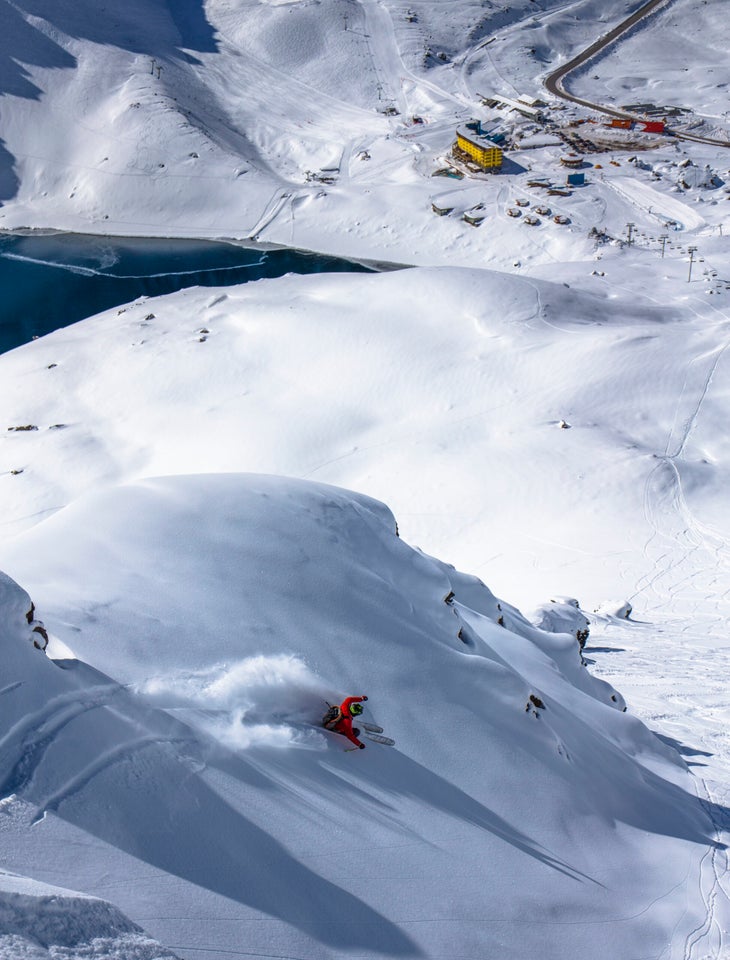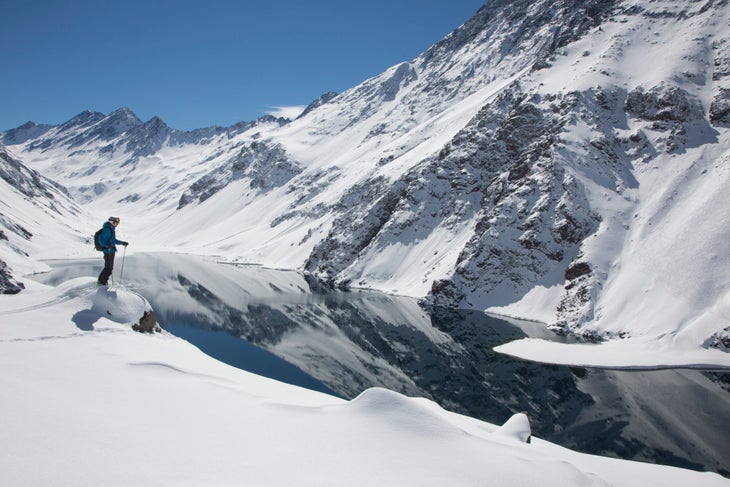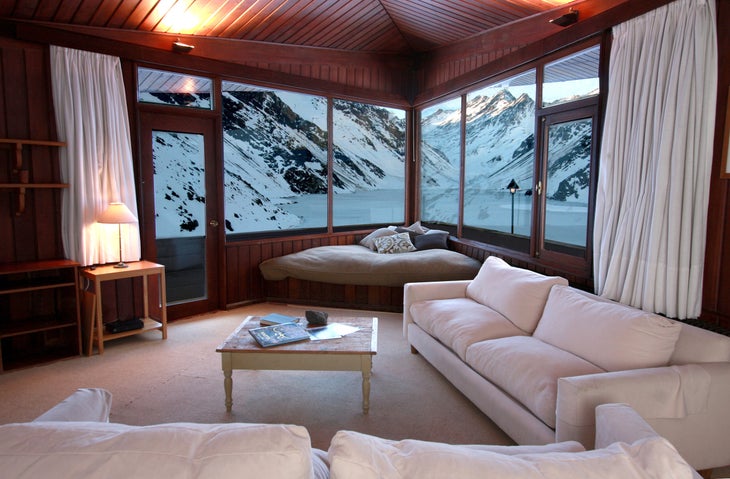Products You May Like
Get full access to Outside Learn, our online education hub featuring in-depth fitness, nutrition, and adventure courses and more than 2,000 instructional videos when you sign up for Outside+
Sign up for Outside+ today.
Ten years ago, I sat in the back of a bus, staring out the window as the driver wound his way up dozens of twisty curves along the Trans-Andean highway toward Portillo, Chile, a ski resort deep in the Andes along the border of Argentina. Near the ski area, the highway crosses under a two-person chairlift. For a moment, there’s this strange and wonderful juxtaposition between truck drivers on their way to an international border and skiers heading to their next powder run.
When we pulled into Portillo’s hotel, a welcoming yellow box at the base of a striking alpine lake called Laguna del Inca, a huge St. Bernard waddled out to greet us. It was August 2012, and my husband, Dan, and I were there for our honeymoon—we’d gotten married the previous spring during a massive snowstorm in Tahoe. Both zealous skiers, the idea of skiing in the summer was too novel to pass up. It would just take 24 hours of hauling ski bags through airports and not sleeping on overnight flights to get there.

We arrived on a powder day at Portillo and took our first lap that afternoon with pro skiers Ingrid Backstrom and Chris Davenport. They had wrapped up their Ski with the Superstars Camp and had just enough time before departing to show us where deep snow was hiding in plain sight off Plateau Superior.
For the rest of that week, Dan and I milked powder turns off El Estadio, making friends on the Roca Jack—a wild five-person Poma lift that rockets you straight up the mountain—who we ended up skiing with for the remainder of our stay. Inside the hotel, we sipped café con Leche by morning and pisco sours by night in the lounge, gawked at the alpenglow from the hot tub overlooking the lake, and stayed up late listening to live music in the bar.
This past August, we returned to Portillo, a decade since our first visit. Dan and I brought along our two kids, ages 6 and 8. When we pulled into Portillo, having made it up that twisty highway, a loving St. Bernard named Petra was asleep on the stoop. (Portillo has had St. Bernard dogs as greeters for nearly 70 years.)
As the world buzzes frantically around us and years seem to fly by in a flash, Portillo has a sacred timelessness to it, a slower pace, and a throwback vibe. Vintage photos of European ski racers and Portillo’s founding family, the Purcells, dot the hallways. Teatime with freshly baked scones from the panaderia downstairs remains a longstanding afternoon tradition. And nobody rushes out the door in the morning.

photo:Adam Clark (Photo: Adam Clark)
I aged ten years between trips here, yet this ski area feels like a time capsule, a tribute to skiing’s storied past. Spend a week here, and the inevitable race of time seems to slow to a lazy crawl. Admittedly, this place isn’t easy to get to, and it’s not inexpensive (a seven-night stay in the hotel, including your lift tickets and four meals a day, starts at $2,650), making it a retreat enjoyed by the lucky few. The hotel houses around 300 guests and draws in skiers from June through October, hailing mainly from North America, Brazil, and Chile.
Constructed by the Chilean government and initially only accessible via railway, Portillo opened its hotel in 1949, when the Chilean Army did grooming and ski instructors were brought in from Europe. By 1960, the ski resort went up for auction, and two North Americans, Bob Purcell and Dick Aldrich purchased it. Bob hired his nephew, Henry Purcell, then 26 and a graduate of the Cornell School of Hotel Administration, to work as the general manager. In 1966, Portillo gained international notoriety by hosting the first FIS World Championships in the Southern Hemisphere.
In 1980, Henry and his brother, David, bought the hotel, naming the mid-mountain restaurant—famous for its lake views and sun-soaked lunches—after their uncle, Tio Bob. These days, Henry, who’s now in his 80, still skis every day at Portillo, while his son, Miguel Purcell, is the general manager.

Not much changes around here. The same maître d’ in the dining room, a round, jovial man in a navy blazer named Juan Beiza, has been there for decades. Operations manager Mike Rogan, an American, has been working here since 1989 and has barely missed a season (except during the COVID pandemic, when Portillo essentially shut down for two straight years). During my recent trip there, I was skiing down from the Super C couloir—an iconic 5,000-vertical-foot backcountry run above the ski area that requires a hefty bootpack to reach—Rogan was waiting near the bottom of the runout.
I asked Rogan what people should know about Portillo before they go. “Expect something different than what you are used to in the States. Don’t rush. Let Portillo do its thing,” Rogan told me. “Too many people arrive with the rushed energy of their lives back home. Let your kids explore, take your boots off for lunch, go to the pool mid-day, and have tea time. Embrace that Hotel Portillo is a classy, older place that some could say is stuck in time, but I think it is perfect.”
Of course, some necessary things have been updated at Portillo over the years. A few years back, the resort invested $3 million in snowmaking equipment, and two new four-person poma lifts were added to increase access to steep, open bowls. When the lake stopped consistently freezing over, they had to cut a trail through the rock face so skiers could return from the Lake Run. All the guestrooms were renovated over the course of three years. The couches in the lounge were reupholstered, and the gym was redone.
Still, there are many staples like Frank Coffey, who has been head of snow safety since 1997. He says some things have changed here for the better. “My second week in Portillo in 1997 it snowed over 13 feet in five days,” Coffey told me. “The road to Portillo was closed for nine days. The highway department in Chile is doing a much better job of clearing the highway to Portillo these days.”
Ingrid Backstrom, who was there the first time I arrived at Portillo has been going to Portillo for 20 years now, give or take a couple of seasons. People like Coffey are why she keeps going back. “What’s really special about Portillo is the people who work there who you see every year, the people who run the place, the guests who have been going for 20 years that I see every time,” Backstrom says. “That is so special to be able to go back to a place and have that feeling, that really welcoming, celebratory feeling of camaraderie that crosses language boundaries.”
Backstrom says when she first started going to Portillo in the early 2000s, people would play board games in the lounge and go to a computer room to use the dial-up internet. “These days, people are still playing games, though thankfully the dial-up room is gone,” she laughs. “It’s a social place, and that fabric is still very much alive.”
By the time our week at Portillo is over, I’m sad to leave. My kids are, too. But there’s comfort in this feeling that if, or when, I return to Portillo, the only thing that will have changed will be me.
